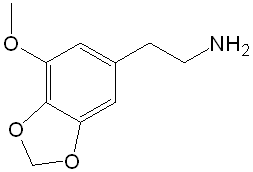Assessment |
Biopsychology |
Comparative |
Cognitive |
Developmental |
Language |
Individual differences |
Personality |
Philosophy |
Social |
Methods |
Statistics |
Clinical |
Educational |
Industrial |
Professional items |
World psychology |
Biological: Behavioural genetics · Evolutionary psychology · Neuroanatomy · Neurochemistry · Neuroendocrinology · Neuroscience · Psychoneuroimmunology · Physiological Psychology · Psychopharmacology (Index, Outline)
| Lophophine | |
|---|---|
| Chemical name | 3-methoxy-4,5-methylendioxyphenethylamine or 2-(7-methoxy-1,3-benzodioxol-5-yl)ethanamine |
| Chemical formula | C10H13NO3 |
| Molecular mass | 211.258 |
| Melting point | 164-164.5 °C hydrochloride |
| CAS numbers | 1484-85-1 |
| SMILES | NCCc1cc2OCOc2c(c1)OC |
 | |
Lophophine, homomyristicylamine, (or 3-methoxy-4,5-methylendioxyphenethylamine) is an homologue of MMDA. It is also related to mescaline and Alexander Shulgin suggests it could be a natural component in the peyote cactus because it is the only logical chemical intermediate for the biosynthesis of several of tetrahydroisoquinolines known to be present in the cactus. Lophophine produces hallucinogenic, psychedelic, and entheogenic effects that are similar to mescaline.
Chemistry[]
Lophophine is in a class of compounds commonly known as phenethylamines, and the full chemical name is 2-(7-methoxy-1,3-benzodioxol-5-yl)ethanamine.
Effects[]
Little is known about the psychopharmacological effects of lophophine, but it does appear to have qualitative and quantitative effects that resemble mescaline. Shulgin reports in Mescaline: The Chemistry and Pharmacology of its Analogs that lophophine is active at 150-250 mg. He states at these dosages that the action of this base is quite similar to that of mescaline; there is a peaceful elevation of mood, euphoria, enhancement of visual perception, and the generation of eyes-closed imagery. At dosages above 300 mg, visual distortions that resemble those of mescaline begin to appear. He also notes that in contrast to mescaline, little nausea is produced from lophophine ingestion.
Pharmacology[]
The mechanism that produces the hallucinogenic and entheogenic effects of lophophine is unknown. Although structure-activity relationships mean that it is likely to be caused by 5-HT2A receptor agonism - similar to other psychedelic drugs such as LSD and Mescaline.
Dangers[]
The toxicity of lophophine is not known.
Legality[]
Lophophine is unscheduled and unregulated in the United States, however because of its close similarity in structure and effects to MDA and MMDA, possession and sale of lophophine may be subject to prosecution under the Federal Analog Act.
See also[]
External links[]
Categorization[]
Psychedelic phenethylamines
| |
|---|---|
Aleph • 2C-B • 2C-B-FLY • 2C-C • 2C-D • 2C-E • 2C-F • 2C-G • 2C-I • 2C-N • 2C-O • 2C-O-4 • 2C-P • 2C-T • 2C-T-2 • 2C-T-4 • 2C-T-7 • 2C-T-8 • 2C-T-9 • 2C-T-13 • 2C-T-15 • 2C-T-17 • 2C-T-21 • 2C-TFM • 3C-E • 3C-P • Br-DFLY • DESOXY • DMMDA-2 • DOB • DOC • DOET • DOI • DOM • DON • Escaline • Ganesha • HOT-2 • HOT-7 • HOT-17 • Isoproscaline • Lophophine • MDA • MMDA • MMDA-2 • MMDA-3a • MMDMA • Macromerine • Mescaline • Proscaline • TMA |
.
- de:3-methoxy-4,5-methylendioxyphenethylamine
- pl:Lophophine
| This page uses Creative Commons Licensed content from Wikipedia (view authors). |